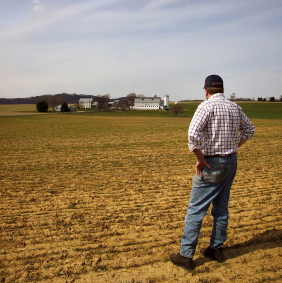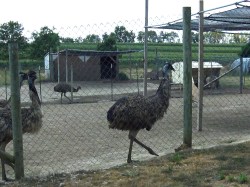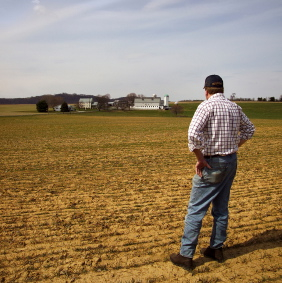 There is something distinctly pathos-inducing about a corn plant dying of thirst. Maybe that’s why coverage of the 2012 drought has focused on commodity crops, especially corn. Reading the reports, you almost expect Tom Joad to step out from between the brown-baked stalks, as if Steinbeck were writing the copy.
There is something distinctly pathos-inducing about a corn plant dying of thirst. Maybe that’s why coverage of the 2012 drought has focused on commodity crops, especially corn. Reading the reports, you almost expect Tom Joad to step out from between the brown-baked stalks, as if Steinbeck were writing the copy.
For non-commodity farms — a category that includes many diverse, organic, and locally supported operations — the story is about much more than maize. A month into summer, the drought has walloped small Midwestern farmers, the very same farmers already struggling to survive a weak economy, a market dominated by rapacious agribusinesses, and, oh yeah, climate change.
For one thing, the ferocious drought has exposed a great lack of irrigation equipment on small farms. In a typical year, summer rain is common in the Midwest, and many of the region’s fruit growers have never irrigated their orchards. Community-supported agriculture (CSA) farmers also tend to lack the infrastructure to water everything they grow.
“You drive around the countryside and whoever doesn’t have irrigation doesn’t have much of a crop,” says Tom Kercher, who grows tree fruit and vegetables in Goshen, Ind.
Dela Ends runs a CSA operation in Brodhead, Wis. This summer she and her husband Tony have been filling a 450-gallon tank three times a day, and towing it to the fields, where it feeds drip lines. But this system won’t cover their 50 acres. “We just don’t have enough man power or water tanks to get to the fields that are farther away,” says Ends. “We’ve never had to water those fields.”
Not that surviving the drought is a simple matter of buying new irrigation systems. The equipment must be kept operating full tilt around the clock, day after day, and in difficult conditions.
“We’ve had mechanical issues and breakdowns,” Kercher says. “A gearhead failed. It’s not a few hundred dollars to fix that. Plus there’s all the diesel fuel to run these pumps. You work yourself to death to keep the irrigation equipment running.”
The lack of irrigation ties into another pressure point: a widening scarcity of animal feed. Feed crops like alfalfa often go unirrigated in favor of more valuable crops, as do grazing pastures.
“The pasture is drying up,” says Joylene Reavis, another small Wisconsin farmer. “What the sheep have eaten down isn’t growing back. That means having to find them hay. Right now, hay is in scarce supply. Feed prices are going up every day.”

Cows on Marybeth Feutz’ farm must subsist on hay, now that the pasture has dried up.
In southern Indiana, where the drought has reached extreme proportions, Marybeth Feutz and her husband John are facing a similar predicament with their small herd of beef cattle. “Our pastures are done,” says Feutz. “There’s no new growth. We’ve turned to feeding hay already because there is not enough grass for the herd.”
The Feutzes usually harvest 10 bales of hay at this time of year, which go into the barn for winter. This year, the fields produced just two, and those may soon be eaten.
“Because we’re feeding hay so early and the hay ground isn’t producing, we’re concerned about having enough to get through the winter,” says Feutz, who has been chronicling the drought on her blog.
These two challenges — lack of irrigation and dwindling feed stocks — are compounded by the second-class status forced upon many small farmers. “Some of the larger farms do business with multiple feed sources, so if one dries up they can move on to others,” Feutz explains. “Farmers around us are already looking outside the state for hay sources. If these get bought up early by the big farms, it will be even harder for small farms to find enough hay.”
Bryn Bird runs a CSA farm in Newark, Ohio, northeast of Columbus. “We’re probably going to have 100 percent sweet corn failure this year,” she says. “That’s probably 30 percent of our income.” Bird estimates the loss of her corn at between $30,000 and $40,000.
Having 210 CSA members invested in the farm — whom Bird is providing with boxes of vegetables she’s irrigated — will help the operation survive, even if she can’t offer them the variety some would prefer. But, Bird adds, “It’s been a good chance to talk to our members about the risks of eating local.”
Despite the media’s constant coverage of their losses, commodity farmers (or those who grow less-perishable crops like corn, wheat, and soy) are eligible for government-subsidized crop insurance and do not face the same kind of lost income that “specialty crop” growers do, says Bird. “I drive around and see the fields of [commodity] field corn and know they are insured. Even if they have 100 percent failure, they’re going to get a check in the mail. We’re completely uninsured. In Ohio, we don’t have specialty crop insurance.”

Emus — like these from Joylene Reavis’ farm — adapt easily to drought and heat.
Moreover, if Congress decides to provide additional drought relief, as Illinois’s governor has urged, big commodity farms get to be first in line. “If it comes down to government help, it usually goes to large farmers instead of small ones,” Joylene Reavis explains. “We probably wouldn’t qualify because we have a small number of acres.”
In addition to sheep, Reavis raises emus for meat and oil. She currently has 100 of the Australian birds strutting around her 10 acres. Toughened by a desert habitat, the creatures long ago adapted to extreme heat and drought.
The question is: How many small farmers will survive long enough to do the same?


